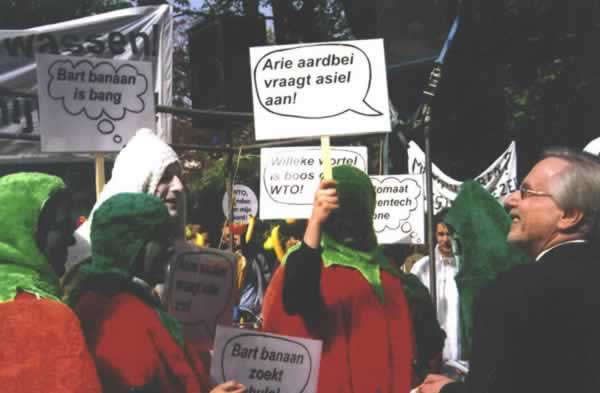Wieteke van Dort draagt diverse schilderijen op aan klokkenluiders (o.a. tegen gentech, wolmanzouten en aspartaam) tijdens expositie in Pulchristudio, Den Haag. (Van 18 december 2004 tot 7 januari 2005).

Brussels, 29 November 2004 – Europe’s member states today voted against proposals to overturn the bans of genetically modified (GM) crops in five countries. The GM position of the European Commission, who tabled the vote, has been described by Friends of the Earth as “deeply unpopular and clearly undemocratic”.
Zie GM-Watch, 29-11-2004: Europe votes to keep GM crop bans
Vanuit de hele wereld ontvangen we steunbetuigingen voor ons burgerinitiatief Lelystad Gentechvrij.
Nader uitwerken!!! Wat citaten of opsomming a la
O.a. van Devinder Sharma, Dr Mae-Wan Ho, Wieteke van Dort, Arpad Putzai, Susan Bardocz, Biologica, Stichting Natuurwetmoeders, Margje Vlasveld, Piet Walraven, Jan Juffermans, Andrea Schulte & Frank W. Lotz,
Zie dossier Lelystad Gentechvrij
HOUSTON, June 21, 2004 — First discovered in abundance three years ago, scientists around the world are racing to find and study microRNAs — tiny strands of ribonucleic acid (RNA) that regulate gene expression in plants and animals.
Zie SienceDaily: Scientists Discover New Role For Tiny RNA In Plant Development
Commentaar van Miep Bos:
What weten we nu van DNA? Heel weinig, waarom laten we het niet ongemoeid, en bewonderen we hoe mooi en perfect alles is gemaakt
26 April 2004, Den Haag
Een demonstratie van Milieudefensie
“WTO hands of my plate”
Een paar foto´s:

Op deze foto zie je de vertegenwoordiger van de Ambassade van Luxemburg. Zij zijn tegen markttoelating en teelt Bt 11 mais, vanwege mogelijke gezondheidsrisico´s. Lees verder “Demonstratie: WTO hands off my plate”
The world’s first genetically modified wheat is to be shelved because of consumer resistance.
BBC, 11-4-2004: Monsanto drops plans for GM wheat.
Scientists investigating a spate of illnesses among people living close to GM maize fields in the Philippines believe that the crop may have triggered fevers, respiratory illnesses and skin reactions.
en
“With such evidence of possible human health impacts of foods already on the market, we believed that waiting to report our findings through publication would not be in the public’s interest.”
en
Monsanto said it was “extremely unlikely” that the limited production of the GM crop in the Philippines would have produced such results.
John Vidal, environment editor, Friday February 27, 2004, The Guardian: Scientists suspect health threat from GM maize
28-01-04 Succes bij het protest door 85 ondertekenaars in Lelystad betreffende:
Notificationnumber C/GB/03/M5/3 Glufosinate-tolerant Rice, LLRICE62 van Bayer CropScience;
zie de Public comments file
De aanvraag om deze gentechrijst via Groot-Brittannië op de markt te mogen brengen, werd ingetrokken.
Zie ook de eerdere publieke commentaren in 04-09-2003.
The GM industry must have been scratching its head on Thursday morning following news that yet another of its key claims had been spectacularly demolished. Far from benefiting the environment, as Monsanto spent millions of pounds telling us it would, we now know that genetically modified crops are bad for diversity. That at least is the conclusion of the Government’s long-awaited field trials.
Third World Network Biosafety Information Service, 28 July 2003.
Monsanto has maintained that there is no difference between GM soybeans and its conventional strains. But according to a Japanese scientist, whose report is attached below, safety tests conducted by Monsanto are riddled with flaws that include: testing of proteins not derived from the GM plant; soybeans used for tests were not produced with Roundup, therefore the data obtained with such samples may not be valid to guarantee the safety of soybean that human and animals consume in real life; insufficient feeding experiments; and intentional neglect of “inappropriate” data which have a bearing on the final conclusions.
Bron: OCA: Flaws in Monsanto’s Safety Assessment of Roundup Ready Soybeans